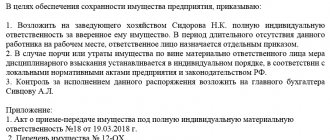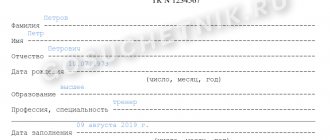What is a personnel order?
This term is absent in the Labor Code of the Russian Federation. Such orders are generally considered to be all official papers that relate to personnel document flow, for example:
- about hiring;
- transfer to another position;
- dismissal;
- change of personal data;
- changes in wages or bonuses;
- about vacation;
- about a business trip.
Some of them need to be kept in the organization for 5 years, but most orders are kept for 75 years. This is why it is so important to keep correct records.
How to register orders
The registration process involves transferring the details of an order for personnel into a certain established form and assigning a number and date to the document.
All types of personnel orders must be registered. Why is it important? The fact is that a draft document acquires legal force upon its registration. If there was no registration process, there are no legal consequences for the employee and employer.
Registration helps solve 3 problems:
- accounting;
- execution control;
- the ability to quickly access personnel orders.
You need to register once - upon publication.
When there are many orders for personnel, numbers can be set for each procedure individually; if there are few, continuous numbering is possible. For example, orders for admission, transfer and dismissal are given a single numbering, for various vacations - a different number.
The registration form can be:
- magazine or book;
- database.
The journal format involves a detailed reflection of information about who developed the document and for what purposes. An automated database involves entering information about orders using specially developed software.
Personnel orders
Order
– a legal act issued by the head of a management body (enterprise, organization), acting on the basis of unity of command, to solve the main and operational tasks facing this body.
ORDERS FOR PERSONNEL
Orders for personnel
formalize the labor relations between employer and employee, which are regulated by the Labor Code of the Russian Federation. In accordance with part three of the Labor Code of the Russian Federation, which establishes the logic of regulating labor relations, as well as taking into account the significance of management action from the point of view of current legislation and the value of the document, which is expressed in its storage period, orders for personnel are classified quite simply.
First group
– orders formalizing labor relations and essential facts of the implementation of the employee’s labor function (relating to the terms of the employment contract) and having
a shelf life of 75 years :
- about hiring (conclusion of an employment contract);
- on transfer to another job (permanent transfer with the consent of the employee, i.e. changing the employment contract);
- about dismissal (termination of employment contract);
- on the establishment of wages (changes in wages as a change in the essential terms of the employment contract);
- about sending on a business trip (long-term foreign);
- about encouragement (bonus, declaration of gratitude, awarding a valuable gift, certificate of honor, etc.).
It should only be noted that orders for the appointment of the first persons of the enterprise, those officials who are mentioned in the charter (for example, the general director, his deputies, chief accountant, head of the internal control service), are orders for the main activity, and not for personal composition.
The second group is orders that promptly regulate the performance of a labor function by an employee and have a shelf life of 5 years :
- on granting leave;
- about sending on a business trip (short-term);
- on the application of a disciplinary sanction (remark, reprimand, etc.);
- on referral to training (seminar) as part of professional training, retraining and advanced training.
This classification of orders is reflected in the structure of Article 6 of the “List of standard management documents generated in the activities of organizations, indicating storage periods.”
REGISTRATION OF ORDERS
Registration is the transfer of document details into a specific registration form (magazine, book, card index, database) and affixing a number (or index) and date to the document.
All types of orders for personnel must be registered. Registration in journal form provides a good solution for the protection and recording of documents. The last entry shows the total number of registered documents. All registration data is compactly grouped in one or more journals, which are subject to special storage. It is impossible to remove entered data from the journal or register a document retroactively. All these advantages of the journal registration form ensure its use today, despite the presence of new technologies that allow automating the registration of documents.
The obligation to maintain accounting forms in journal form is established by regulatory documents (List of standard management documents generated in the activities of organizations, indicating storage periods; Inter-industry integrated time standards for staffing and accounting work).
has developed convenient journals for recording orders and registering orders
. Depending on the volume of personnel document flow, various types of journals can be used.
- Logbook for registering orders for personnel
- Journal of registration of personnel orders
- Leave order log
- Journal of registration of orders for main activities
- Order log
All registration journals (books)
are carried out until completely filled. On the cover of each registration book, you should write the name of the organization (institution) and put the date of establishment of the journal, and after the book is completely filled out, the end date. If during the maintenance of the journal the name of the organization (or its legal form) changes, then clarifications should be made on the cover of the journal.
More information about the rules for registering orders can be found in the article by L. Sankina “Journals of registration of personnel documentation.”
EXAMPLES OF ORDERS
RECEPTION
- Form T-1. Unified form of admission order
- Form T-1a. Unified form of admission order (several people)
- T-1. Order for permanent employment
- T-1. Order for admission to permanent employment, without testing
- T-1. Order for admission to seasonal work
- T-1. Order for part-time admission
- T-1. An order for admission, temporarily, for the period that another employee is on parental leave
- T-1. Order for acceptance, temporarily, for the period of work
- T-1. Order for admission, urgent, for medical reasons
- T-1. Order of admission, age up to 18 years, shortened working hours
- T-1. Order of admission, part-time
- T-1. Order of admission, part-time work week
- T-1. Order of admission, part-time work
- T-1. Order of acceptance, with full financial responsibility
- T-1. Admission order, manager and deputies, 6 month trial
- T-1a Order for permanent employment (several employees)
- Order on cancellation of an employment contract
TRANSLATION
- Form T-5. Unified form of transfer order
- Form T-5a. Unified transfer order form (several employees)
- T-5a Order for the transfer of several employees (example)
- T-5. Transfer order due to staff reduction
- T-5. Order for transfer due to health reasons
- T-5. Transfer order, promotion
- T-5. Transfer order, temporary, due to work injury
- T-5. Transfer order, temporary due to pregnancy
- T-5. Transfer order, temporarily, until the child reaches one and a half years old
- T-5. Order for transfer based on certification results
- Order on moving an employee to another structural unit
- Order on temporary transfer to another unit
WORKING AND REST TIME
- Form T-6. Unified vacation order form
- Form T-6a. Unified vacation order form (several employees)
- T-6 Order on granting leave (sample)
- T-6a Order on granting leave (several employees) (sample)
- T-6 Order on the provision of maternity leave
- T-6 Order on granting maternity leave to an employee who has adopted a child
- Order on providing an additional day of rest to a donor employee
- Order on postponing employee leave
- Order on replacing part of the vacation with monetary compensation
- Order on replacing additional leave with monetary compensation
- Order on early release of an employee from leave without pay
- Order on the early release of an employee from parental leave
- Order on the extension of an employee’s annual paid leave due to temporary disability
- Order on the release of a donor employee from work on the day of blood donation
- Order on working hours
- Order on establishing reduced working hours
- Order on establishing part-time working hours
- Order on part-time work
- Order on employment at night
- Order on involvement in overtime work (without the employee’s consent)
- Order on involvement in overtime work
- Order on provision of additional rest time
PART-TIME, COMBINATION, ADDITIONAL AMOUNT OF WORK
- Order on combining positions
- Order on the performance of duties of a temporarily absent employee
- Order on increasing the volume of work performed
INCENTIVES AND PENALTIES
- Form T-11. Unified form of order for promotion
- Form T-11a. Unified form of order for promotion (several employees)
- Order on imposing a disciplinary sanction (reprimand)
- Order on removal of an employee from work
BUSINESS TRAVELS, DIRECTION FOR TRAINING
- Form T-9. Unified form of order for sending on a business trip
- Form T-9a. Unified form of order for sending on a business trip (several employees)
- T-9 Order on sending on a business trip (short-term)
- T-9a Order on sending several employees on a business trip (short-term)
- Order on reimbursement to an employee of expenses incurred on a business trip
- Order On sending employees for advanced training (with a break from work)
TERMINATION (Termination of employment contract)
- Form T-8. Unified form of order for termination of an employment contract (dismissal)
- Form T-8a. Unified form of order to terminate an employment contract (several employees)
- T-8 Order On termination (termination) of an employment contract (dismissal) at the initiative of an employee due to the need to care for a child under 14 years of age
- T-8 Order On termination (termination) of an employment contract (dismissal) in connection with the provision by the employee of false documents to the employer when concluding an employment contract
- T-8 Order on termination (termination) of an employment contract (dismissal) in connection with the court recognizing the employee as missing
- T-8 Order on termination (termination) of an employment contract (dismissal) due to unsatisfactory test results
- T-8 Order on termination (termination) of an employment contract (dismissal) due to repeated failure by an employee to fulfill job duties without good reason
- T-8 Order on termination (termination) of an employment contract (dismissal) in connection with a one-time gross violation of labor duties by an employee
- T-8 Order on termination (termination) of an employment contract (dismissal) in connection with the commission of guilty actions by an employee directly servicing monetary assets, giving grounds for loss of confidence in him
- T-8 Order on termination (termination) of an employment contract (dismissal) in connection with the reinstatement of an employee who previously performed this work, by court decision
- T-8 Order On the termination (termination) of an employment contract (dismissal) in connection with the deprivation of an employee of a special right (to drive a vehicle), entailing the impossibility of the employee fulfilling his duties under the employment contract
- T-8 Order on termination (termination) of an employment contract (dismissal) due to violation of the established rules for concluding an employment contract, excluding the possibility of continuing work
- T-8 Order on termination (termination) of an employment contract (dismissal) in connection with the employee’s refusal to transfer to another job, necessary for him in accordance with a medical report
- T-8 Order on termination (termination) of an employment contract (dismissal) in connection with the employee’s conscription for military service
- T-8 Order On termination (termination) of an employment contract (dismissal) in connection with the hiring of an employee for whom this work will be the main one
- T-8 Order on termination (termination) of an employment contract (dismissal) in connection with the commission of an immoral act incompatible with the continuation of work
- Order on reinstatement at work
- Order on cancellation of an employment contract
OTHER PERSONNEL ORDERS
- Order on changing surname
- Order on changing patronymic
Journal design requirements
Labor legislation does not establish requirements for the availability and design of a magazine. The institution itself determines the form and algorithm for maintaining the document. The most acceptable option is the electronic format: it requires less costs than working with paper media.
The logbook for registering orders for personnel is designed to systematize and streamline personnel document flow and allows you to handle a large amount of information simultaneously, and also performs the following functions:
- registration of personnel documents issued by the company;
- quick search for accurate information and documents about employees;
- storage and archiving of company papers.
According to paragraph “b” of Art. 258 “List of standard management archival documents generated in the course of the activities of state bodies, local governments and organizations, indicating storage periods” (dated 08/25/2010 No. 558), the employer must maintain a registration log. The current legislation does not provide for mandatory requirements for its form and content, and does not establish liability for its absence.
It is advisable to approve a sample of filling out the journal of orders for personnel by a local regulatory act of a legal entity, as well as a sample of an order for personnel.
Electronic accounting of personnel documents
Most employers keep personnel records electronically, therefore, an important task is to optimize its digital version in accordance with the real needs of the organization. The electronic form can always be adjusted: add the necessary details, change their sequence, generate the necessary report for printing. In the electronic version, searching for the necessary information takes much less time. At the end of the reporting year or other period, the unified accounting register is printed and archived along with the corresponding personnel documents. Maintaining a book in electronic form is especially important for large organizations where personnel records are published by several structural divisions and branches. As a rule, the registration book is automatically generated by the program and contains the following data:
- Publication date.
- Unique registration number in the program.
- Short description.
- Executor.
Logging Rules
The book of accounting of normative documentation is kept in free form. For notes, you can use a regular notebook or A4 journal. Since new information will be added regularly, it is advisable to have a book with thick pages and a rigid endpaper. Starting a new book at the beginning of each year will make it easier to find the right document and monitor compliance with instructions.
The name of the institution, details, name of the journal, start and end dates, storage period, position and full name of the person responsible are written on the title page.
On the first spread there is a list of persons responsible for office work and the numbers of orders for their appointment. The rules for maintaining the register are prescribed.
The notebook is numbered to the last page. The sheets are lined with a table, in the columns of which information about administrative acts is entered. The last sheet indicates the number of pages of the form and the number of registered acts, position, full name of the person responsible. You cannot tear out sheets from the notebook or insert additional ones.
IMPORTANT! If an error is made, the entry is crossed out, a note about the error is made, and the date and signature of the clerk are added.
Upon completion, the form is transferred to the archive.
Registration of regulatory documents can also be carried out in electronic form. This option is useful because it makes it easier to find the desired record and does not require transfer to the archive. However, it will not be possible to obtain signatures from employees regarding familiarization. In addition, there is a risk of computer failure.
What information to reflect?
The form records data on the normative act:
- serial number of the position;
- number and date of issue of the order;
- type of order: on hiring an employee, business trip, vacation, changing working conditions, changing personal information (change of name), reorganizing a structural unit, etc.;
- basis for publication: for example, an employment contract or a legislative act;
- brief content: for example, the name of the department and the position of the employee being hired or an instruction to organize the purchase of materials are reported;
- Full name and position of the employee entrusted with the execution of the instructions;
- familiarization signature;
- mark of execution and transfer to the archive.
The given list is indicative. The design of the magazine in the organization and its structural divisions is carried out individually.
Storage periods for personnel logs and orders
Storage periods are regulated by Article 22.1 of the Federal Law of October 22, 2004 No. 125-FZ “On Archiving in the Russian Federation.” As a rule, personnel documents have a standard storage period of at least 75 years from the date of creation. However, some of them have a shorter shelf life of only 5 years:
- about disciplinary sanctions;
- on annual paid leave;
- about study leaves;
- about duty;
- about short-term business trips in Russia and abroad.
The logs are kept for the same amount of time as the personnel documents listed in them—75 years. Or 5 years, if the accounting book recorded only documents that can be disposed of after 5 years.
Orders that are accepted in the organization and are subject to numbering
An order is an administrative document that is adopted by the head of an organization (sole executive body) in order to regulate internal and external legal relations. The types of orders that can be accepted in an organization are reflected in Order No. 558 of the Ministry of Culture of Russia. Of course, the presented list is not exhaustive, but it can give an idea of what orders can be accepted in a company.
Important! The separation of orders from each other and their numbering are also important because each document has its own storage period.
Orders accepted in the organization can be divided into the following types:
Have a question? We'll answer by phone! The call is free!
Moscow: +7 (499) 938-49-02
St. Petersburg: +7 (812) 467-39-58
Free call within Russia, ext. 453
- By personnel. These are orders related to the hiring and dismissal of employees, etc.
- By main activity. These are local acts of any kind, for example, the Regulations on Labor Protection.
- For administrative and economic activities. These are orders on the procedure for visiting production premises, organizing security, etc.









